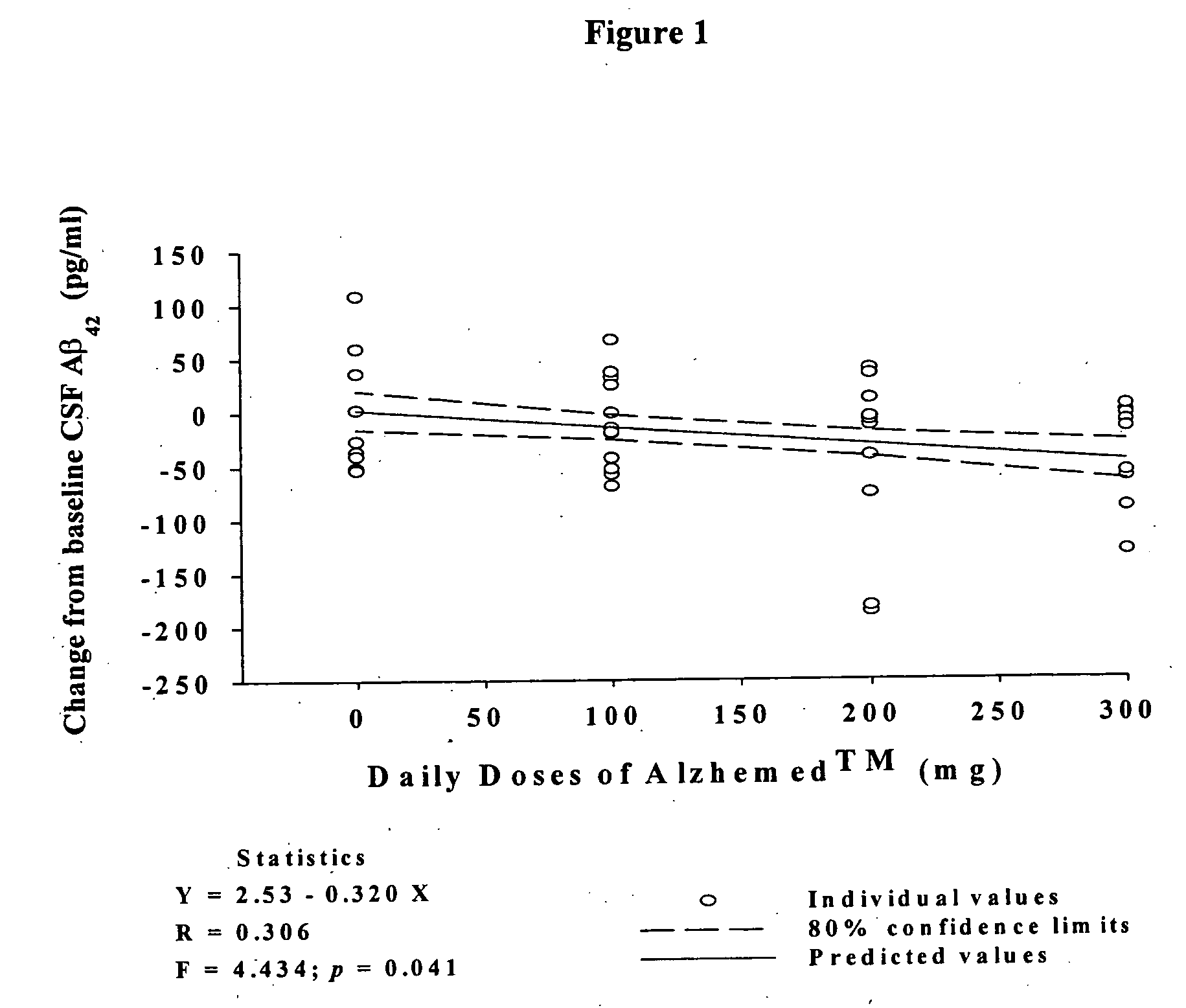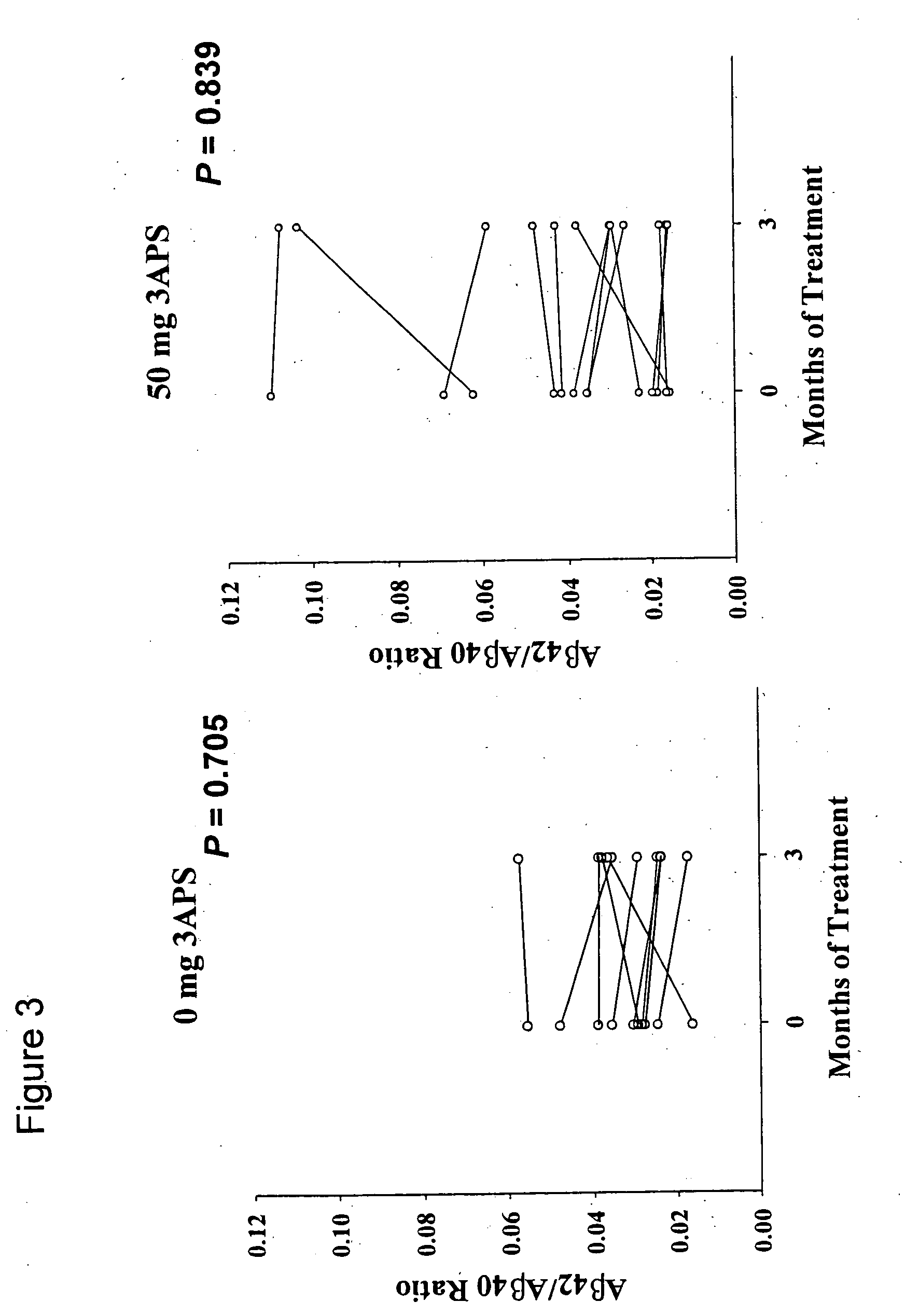Pharmaceutical formulations of amyloid inhibiting compounds
a technology of amyloid and inhibiting compounds, which is applied in the direction of biocide, plant growth regulators, animal husbandry, etc., can solve the problems of increasing the risk of amyloid fibrils, affecting the survival of patients, so as to achieve the effect of higher systemic exposure to the drug
- Summary
- Abstract
- Description
- Claims
- Application Information
AI Technical Summary
Benefits of technology
Problems solved by technology
Method used
Image
Examples
example 1
Gelatin Capsules for Oral Administration
[0426] The unit formula of 100 and 400 mg white gelatin capsules is presented in Table 2.
TABLE 2Unit Formula for 100 and 400 mg Gelatin CapsulesCapsules(mg / capsule)IngredientGradeFunction100 mg400 mg3-amino-1-propanesulfonicMS*Active100 mg400 mgacid, sodium saltIngredientCalcium carbonateNFFiller4.4517.8Magnesium stearateNFLubricant0.552.2
*MS: Manufacturer's Standard, NF: National Formulary; USP: United States Pharmacopoeia.
[0427] Results from certain studies have shown that the administration of 3-amino-1-propanesulfonic acid sodium salt in solid dosage form (capsules) was associated with gastrointestinal symptoms (i.e. nausea and vomiting). Further investigations revealed that the gastrointestinal symptoms were produced, at least in part, by a local irritation due to the high pH generated during the dissolution of amino-1-propanesulfonic acid'sodium salt into the stomach. Additional experiments in dogs (in solid dosage form) have shown t...
example 2
Enteric-Coated Tablets
[0428] The 100 and 400 mg white enteric-coated tablets were prepared according to a formulation in which the drug substance produced by a process utilizing ion-exchange to remove sodium was densified by granulation with water because of its low density and fluffiness. The unit formula of the 100 and 400 mg Enteric-Coated tablets is presented in Table 3.
TABLE 3Unit Formula of 100 and 400 Enteric-Coated TabletsEnteric-CoatedTablet(mg / tablet)IngredientGradeFunction100 mg400 mgCore:3-amino-1-MS*Active Ingredient100.00400.00propanesulfonic acidSilicatedNFGlidant / Diluent350.0070.00mycrocrystallinecelluloseDibasic calciumUSPFiller158.40112.00phosphateHydroxypropyl-USPDrug Release Modifier70.0070.00methylcellulose(HPMC)Starch ® 1500NFBinder / Desintegrant11.1037.50Stearic acid powderNFLubricant7.007.00Magnesium stearateNFLubricant1.800.018Coating:Opadry ® II WhiteMS*Subcoat14.0014.00Acryleze ®MS*Enteric Coat42.0042.00Total Weight:756.00756.00
*MS: Manufacturer's Standa...
example 3
Modified-Release Coated Tablets
[0430] Clinical studies indicated that the role of the enteric-coating and drug release modifier would be significant in the pharmacokinetic (PK) profile of the drug product as well as its tolerability. Accordingly, in order to give particular pharmaceutical performance in terms of PK, tolerability and product stability, drug release modifier was formulated into the tablet. To improve physical stability of the product in terms of film coating acceptability and moisture protection capability, under accelerated conditions, the enteric-coating system was modified by the increase in the amount of enteric-coating and the addition of a topcoat.
[0431] A 50 mg strength modified-release coated tablet consisting of bulk substance (3-amino-1-propanesulfonic acid) and inactive ingredients (silicated mycrocrystalline cellulose, dibasic calcium phosphate, hydroxypropylmethylcellulose, starch, stearic acid, magnesium stearate, as well as Opadry® II white (subcoat a...
PUM
 Login to View More
Login to View More Abstract
Description
Claims
Application Information
 Login to View More
Login to View More - R&D
- Intellectual Property
- Life Sciences
- Materials
- Tech Scout
- Unparalleled Data Quality
- Higher Quality Content
- 60% Fewer Hallucinations
Browse by: Latest US Patents, China's latest patents, Technical Efficacy Thesaurus, Application Domain, Technology Topic, Popular Technical Reports.
© 2025 PatSnap. All rights reserved.Legal|Privacy policy|Modern Slavery Act Transparency Statement|Sitemap|About US| Contact US: help@patsnap.com



